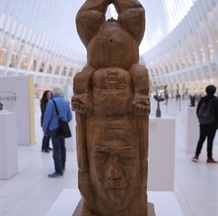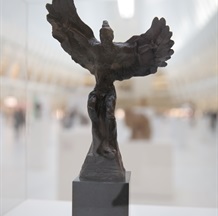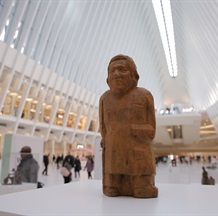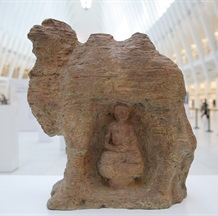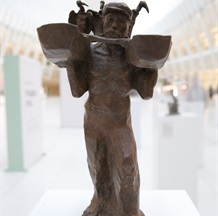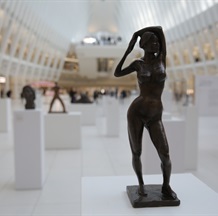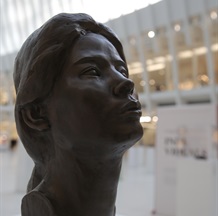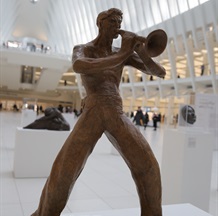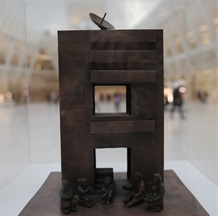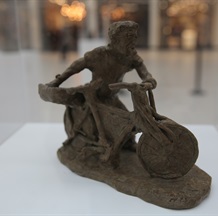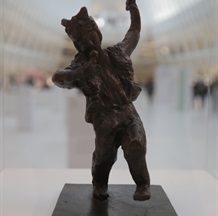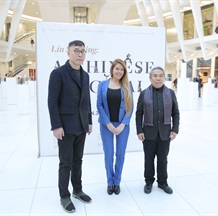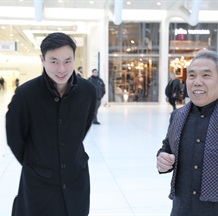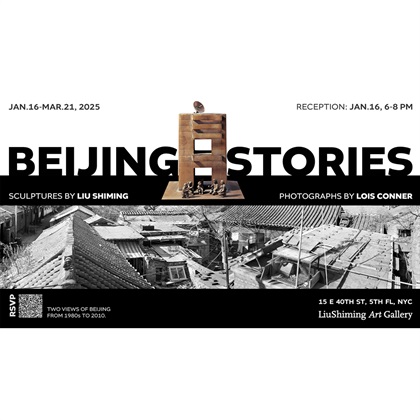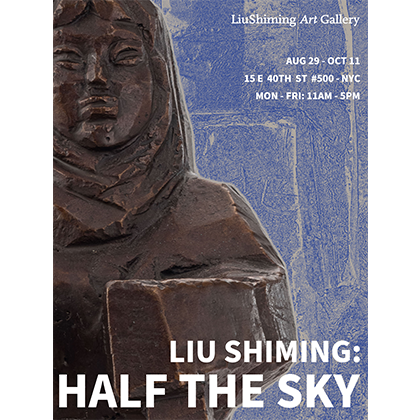The Oculus, World Trade Center (NY) announces "Liu Shiming: A Chinese Original"
Dates:
Jan 29 - Jan 31, 2020
The Oculus, World Trade Center, is pleased to announce the upcoming and exhilarating exhibition of renowned sculptor, Liu Shiming, to celebrate the Chinese New Year.
Liu Shiming (1926-2010), one of China’s most accomplished sculptors, spent a lifetime absorbing China’s cultural traditions and expressing them in his own delightful way. Liu’s work is well known in China, but has never been presented in the West – until now. The exhibition, "Liu Shiming: A Chinese Original", is part of a globally traveling exhibition organized by the Central Academy of Fine Arts.
Throughout the highly anticipated exhibition, 56 sculptures cover Liu’s full career of more than half a century. The talented sculptor loved people and frequently used laborers, parents, and infants as inspiration for his work. Liu spent many years traveling China to fully understand people and their customs and recreated their lives through sculpture, guided by ancient Chinese art styles.
The spellbinding display is divided into four parts, starting with “Innocence,” which features Liu’s love for sculpting small children. The “Roots” section shows Liu’s reverence for his predecessors, while “Working” reflects the importance he placed on ordinary laborers and a good day’s work. Finally, “Individuals” celebrates people and animals creating and pursing their own particular lives, just as Liu himself did.
About the exhibition
"Liu Shiming: A Chinese Original" will be hosted from January 29th – 31st, 2020 at The Oculus, World Trade Center, Church St, New York, NY 10006.
"Liu Shiming: A Chinese Original" is a collaborative event hosted by the Port Authority of New York and New Jersey, the World Trade Center, the Central Academy of Fine Arts, and the Asian Cultural Center USA. The event is organized by the Asian Cultural Center USA, the Liu Shiming Sculpture Museum at the Central Academy of Fine Arts, and co-organized by PLC Ltd. Inc., Academic Advisor Shaojun Wang, and Curator Jenny Roosevelt.
About Liu Shiming
Liu Shiming believed that sculpture should be focused on people and the depiction of people, because people are social beings and creators of art. Liu once said that “when we lose people and the human spirit, art loses its soul.”
On December 24, 2018, the Central Academy of Fine Arts established the Liu Shiming Sculpture Museum, which is dedicated to researching and investigating Liu’s artworks and their art historical meaning. Liu Shiming was part of CAFA’s first generation of Chinese sculptors trained after the founding of the People’s Republic of China. He had significant training in ancient and modern Western sculpture, and his artistic achievements were recognized as early as the 1950s.
Courtesy of the organizer, for more information about Liu Shiming, please visit https://www.lsmsculpture.com/.
Preface from Curator Liu Shiming: A Chinese Original
Welcome to the world of Liu Shiming, one of China’s most accomplished sculptors. Liu (1926-2010) spent a lifetime absorbing China’s cultural traditions and expressing them in his own delightful way. His work is well known in China but has never been presented in the West — until now. This display is part of a globally traveling exhibition organized by Central Academy of Fine Arts.
The 56 sculptures here cover Liu’s full career of more than half a century. As you will see, Liu’s favorite subject was people—laborers, parents, infants. “When we lose people and the human spirit, art loses its soul,” he once said. To truly understand China’s people, he left Beijing early in his career to live and work in the provinces. He immersed himself in the people and their customs. Then he recreated those lives through sculpture, guided by ancient Chinese art styles. Although he was formally trained in art and carefully studied Rodin, Liu’s own work owes more to the Han dynasty (206 BC-280 AD) than to the western art trends popular during his lifetime.
This display is divided into four parts, starting with “Innocence”. Liu loved sculpting small children— and seeing the world through their eyes. The “Roots” section shows Liu’s reverence for his predecessors; he got the ideas for many of the pieces while working for seven years in artifact restoration at the National Museum of Chinese History. “Working” reflects the importance he placed on ordinary laborers and a good day’s work. Finally, “Individuals” celebrates people and animals creating and pursuing their own particular lives, just as Liu himself did. We hope you enjoy the exhibit.
INNOCENCE
Liu loved sculpting small children and seeing the world through their eyes. His favorite subject was his little grandson, Mengmeng. Liu made countless images of Mengmeng in different situations—playing, talking, and thinking. When you see the world through a child’s eyes, Liu believed, everything becomes fresh again. Everything becomes full of love and joy.
ROOTS
Liu immersed himself in Chinese cultural traditions. Through study and travel, he became an expert on ancient art and folklore. He worked for nearly seven years restoring artifacts at the National Museum of China. The job allowed him to study the details of ancient sculptures—and get ideas for his own creations. Largely turning his back on the modern Western art popular at the time, he reached into China’s past and put his own, distinctive stamp on it.
WORKING
As Liu traveled through China’s countrysides early in his career, he carefully studied how people lived their lives. He came to admire how hard they worked at their jobs. He observed farmers, crews of river rafts, backstage theater workers, and others as they tended to their jobs every day. Life, he realized, is work. As his sculptures show, work can be a powerful source of optimism and pride.
INDIVIDUAL
Liu Shiming had enormous respect for the individual. He always looked for what made each person different, and what made each human relationship different. He looked at the animal kingdom in the same way, searching for what was unique in each creature. He empathized with people and animals alike, and his art reflected the dignity of each life. It’s a vision that, in the end, goes far beyond national borders.
Curator Jenny Roosevelt
Liu Shiming (1926-2010), one of China’s most accomplished sculptors, spent a lifetime absorbing China’s cultural traditions and expressing them in his own delightful way. Liu’s work is well known in China, but has never been presented in the West – until now. The exhibition, "Liu Shiming: A Chinese Original", is part of a globally traveling exhibition organized by the Central Academy of Fine Arts.
Throughout the highly anticipated exhibition, 56 sculptures cover Liu’s full career of more than half a century. The talented sculptor loved people and frequently used laborers, parents, and infants as inspiration for his work. Liu spent many years traveling China to fully understand people and their customs and recreated their lives through sculpture, guided by ancient Chinese art styles.
The spellbinding display is divided into four parts, starting with “Innocence,” which features Liu’s love for sculpting small children. The “Roots” section shows Liu’s reverence for his predecessors, while “Working” reflects the importance he placed on ordinary laborers and a good day’s work. Finally, “Individuals” celebrates people and animals creating and pursing their own particular lives, just as Liu himself did.
About the exhibition
"Liu Shiming: A Chinese Original" will be hosted from January 29th – 31st, 2020 at The Oculus, World Trade Center, Church St, New York, NY 10006.
"Liu Shiming: A Chinese Original" is a collaborative event hosted by the Port Authority of New York and New Jersey, the World Trade Center, the Central Academy of Fine Arts, and the Asian Cultural Center USA. The event is organized by the Asian Cultural Center USA, the Liu Shiming Sculpture Museum at the Central Academy of Fine Arts, and co-organized by PLC Ltd. Inc., Academic Advisor Shaojun Wang, and Curator Jenny Roosevelt.
About Liu Shiming
Liu Shiming believed that sculpture should be focused on people and the depiction of people, because people are social beings and creators of art. Liu once said that “when we lose people and the human spirit, art loses its soul.”
On December 24, 2018, the Central Academy of Fine Arts established the Liu Shiming Sculpture Museum, which is dedicated to researching and investigating Liu’s artworks and their art historical meaning. Liu Shiming was part of CAFA’s first generation of Chinese sculptors trained after the founding of the People’s Republic of China. He had significant training in ancient and modern Western sculpture, and his artistic achievements were recognized as early as the 1950s.
Courtesy of the organizer, for more information about Liu Shiming, please visit https://www.lsmsculpture.com/.
Preface from Curator Liu Shiming: A Chinese Original
Welcome to the world of Liu Shiming, one of China’s most accomplished sculptors. Liu (1926-2010) spent a lifetime absorbing China’s cultural traditions and expressing them in his own delightful way. His work is well known in China but has never been presented in the West — until now. This display is part of a globally traveling exhibition organized by Central Academy of Fine Arts.
The 56 sculptures here cover Liu’s full career of more than half a century. As you will see, Liu’s favorite subject was people—laborers, parents, infants. “When we lose people and the human spirit, art loses its soul,” he once said. To truly understand China’s people, he left Beijing early in his career to live and work in the provinces. He immersed himself in the people and their customs. Then he recreated those lives through sculpture, guided by ancient Chinese art styles. Although he was formally trained in art and carefully studied Rodin, Liu’s own work owes more to the Han dynasty (206 BC-280 AD) than to the western art trends popular during his lifetime.
This display is divided into four parts, starting with “Innocence”. Liu loved sculpting small children— and seeing the world through their eyes. The “Roots” section shows Liu’s reverence for his predecessors; he got the ideas for many of the pieces while working for seven years in artifact restoration at the National Museum of Chinese History. “Working” reflects the importance he placed on ordinary laborers and a good day’s work. Finally, “Individuals” celebrates people and animals creating and pursuing their own particular lives, just as Liu himself did. We hope you enjoy the exhibit.
INNOCENCE
Liu loved sculpting small children and seeing the world through their eyes. His favorite subject was his little grandson, Mengmeng. Liu made countless images of Mengmeng in different situations—playing, talking, and thinking. When you see the world through a child’s eyes, Liu believed, everything becomes fresh again. Everything becomes full of love and joy.
ROOTS
Liu immersed himself in Chinese cultural traditions. Through study and travel, he became an expert on ancient art and folklore. He worked for nearly seven years restoring artifacts at the National Museum of China. The job allowed him to study the details of ancient sculptures—and get ideas for his own creations. Largely turning his back on the modern Western art popular at the time, he reached into China’s past and put his own, distinctive stamp on it.
WORKING
As Liu traveled through China’s countrysides early in his career, he carefully studied how people lived their lives. He came to admire how hard they worked at their jobs. He observed farmers, crews of river rafts, backstage theater workers, and others as they tended to their jobs every day. Life, he realized, is work. As his sculptures show, work can be a powerful source of optimism and pride.
INDIVIDUAL
Liu Shiming had enormous respect for the individual. He always looked for what made each person different, and what made each human relationship different. He looked at the animal kingdom in the same way, searching for what was unique in each creature. He empathized with people and animals alike, and his art reflected the dignity of each life. It’s a vision that, in the end, goes far beyond national borders.
Curator Jenny Roosevelt


